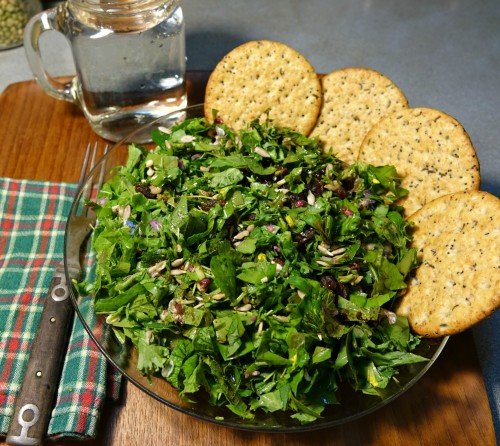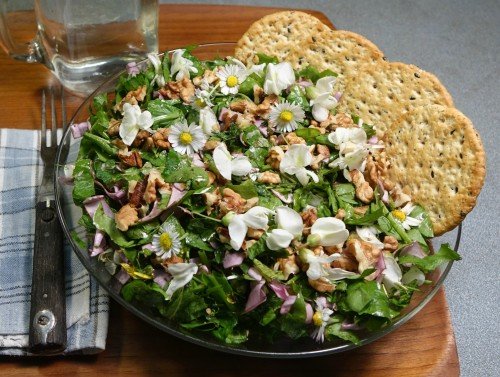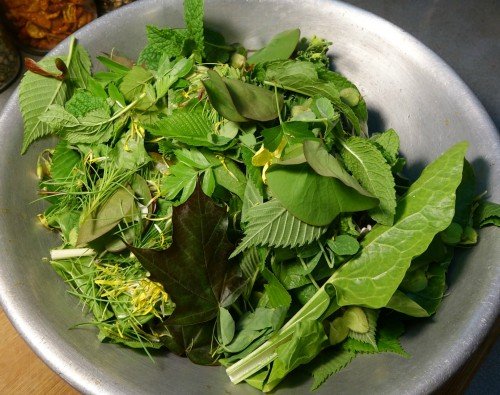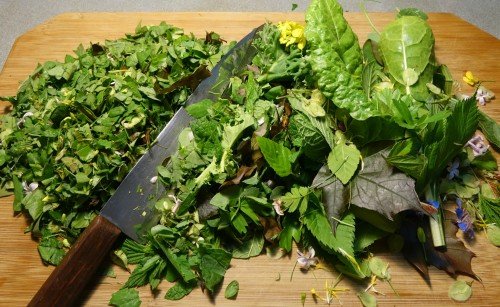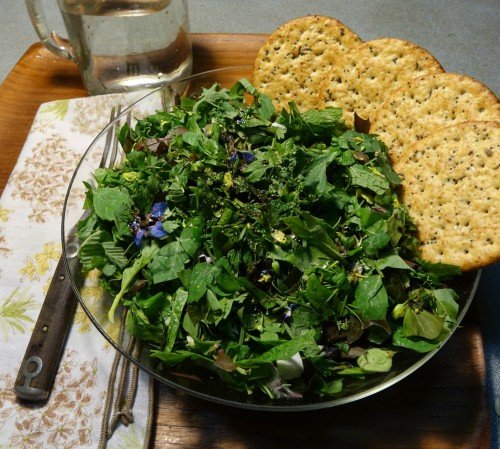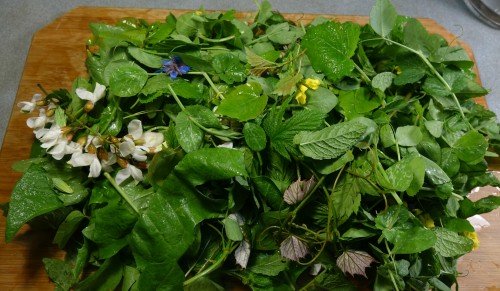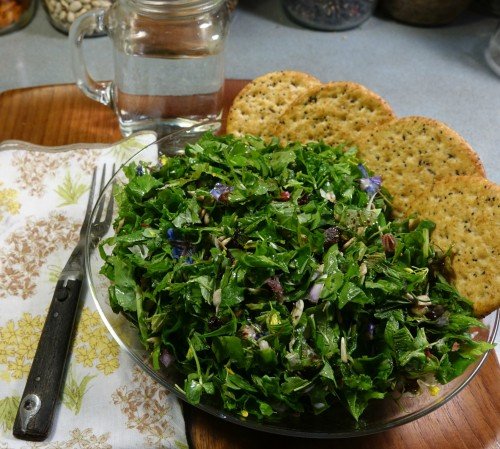It’s no secret to fans of my YouTube channel that there are a lot of weeds here at Haphazard Homestead. And it’s no secret that I eat a lot of them, too! I prefer to think of my yard as a giant buffet. I just have to go out for a walk and see what’s been set out in the salad bar today. Just like any salad bar, some of the plants I use would be too much of a ‘one note song’ all by themselves. But when you mix all these notes together, the song is great!
I just go out for a walk, pick the tasty things here and there, not too much in any one place, and then make my salad. I use tender weeds, tree leaves and flowers, wildflowers, domestic flowers, wild seeds, and sometimes plants from my garden, too. I like mixing a lot of different edible plants, because the flavors all mix so well, and I get a wider variety of nutrients that way, too. I never, ever get tired of a wild salad, and they don't have to be fancy or complicated at all. The flavors are strong because it's all fresh-picked, and the flavors are complex because I mix so many kinds of plants together.
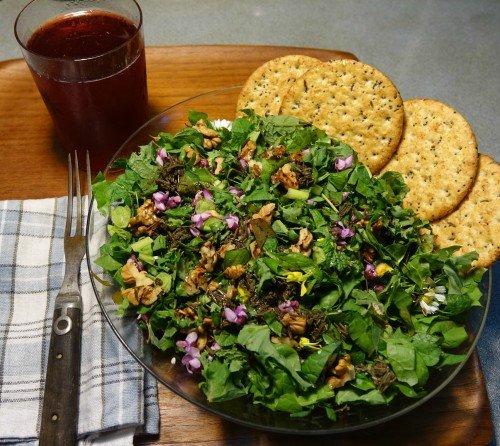
Salad from April 16 with American elm seeds, redbud flowers and young leaves, young maple leaves, dandelion greens, dock, nipplewort greens, field mustard and collard flowers and flowerbuds, English daisy flowers and leaves, wild arugula, hedge mustard, spearmint, lemon balm, small borage leaves, kale, swiss chard, green onions, field pea shoots, and homegrown English walnuts. My dressing was my own homemade spruce needle balsamic vinaigrette. This was really a great salad and went well with the juice from my homegrown, frozen red currants!
Most of these plants are not for sale in a store at any price, but I can pick all I want for free – how great is that! The pictures here are just a sample of the salads I’ve been eating this year, from mid-April to mid-May, 2016. The captions list the common names that I call these plants. I’ve also included a list of the scientific names at the end of this post, for the trees and weeds, so there isn’t any confusion about what plants I’m eating.
After I made this list, I was really surprised at all the different plants that went into these salads just in one month. They are all plants that I don’t have to mess with – they take care of themselves every year, either by being perennial or re-seeding themselves. That includes the garden plants listed, too.
I’d love to know if you eat these plants – and what other weeds, tree leaves, flowers, or seeds you put in your spring salads! Let me know in the comments below! If you want to see more posts about these plants and other wild plants that are great to eat, be sure to hit the follow button for my page!
Salad from April 24 with Elm leaves and seeds, redbud leaves and flowers, hawthorne leaves, new needle growth on Colorado Blue Spruce, Lilac flowers, Rose of Sharon leaves, dandelion leaves, dock leaves, nipplewort leaves, field mustard flowers, red clover leaves, Swiss chard, kale, spearmint, young hop leaves, borage flowers. I added raisins, raw sunflower seeds, and a balsamic vinaigrette.
Why Spring?
I can pick a wild salad almost any time of the year, but the springtime is special because the trees and shrubs are putting out their leaves and some of them are wonderful to eat. These salads change from day to day as the spring season progresses. I like eating these salads because it encourages me to pay close attention to a wide variety of plants in my yard. And it helps me appreciate all the changes that these plants are going through.
In the late winter and late summer, it can take more than 15 minutes to make a good weed salad. In the late winter, the weeds are small, but it can still be worth it to make a salad, especially if I am out wandering my yard anyway. Here in Oregon’s Willamette Valley, where we have very dry summers, by the end of that season most plants are putting their energy into seeds and roots. Once the fall rains start again, we will get a flush of new plant growth, so the salad bar will be restocked and I will be stoked! Until the rains return, I’m making 15-minute salads from my garden – including garden weeds, of course!
Salad from May 14 with field pea shoots, Swiss chard, green onions, pineapple weed flowers and leaves, wild field mustard flowers, English Daisy flowers, rose petals from a Blue Girl, and black locust tree flowers, topped with a simple balsamic vinaigrette and homegrown English walnuts. Mmm. And those pineapple weed flowers do taste like pineapples!
It's a Simple Recipe That's Not Really a Recipe
Spring moves along so fast! There can’t be any specific recipe for these salads, because the mix of what I pick is completely determined by the weather and how the plants respond. That changes from year to year. If there is a hot spell, some plants can be done in a week. If the spring is cool, I can pick from those same plants for a month. Sometimes I mix in plants from my spring garden. But I try not to add too many, because I like the taste of the wild plants.
Here’s how I put together my homestead salads.
- Grab a big bowl and a knife, and take a walk around the yard.
- Pick some of the edible plants I see. Pick clean! No sticks, grass, or other plants – just the right part of the right plants. Pick organized! Keep each kind of plant in its own place in the bowl.
- Keep moving! Try to pick 4 times more than you think you could possibly need. When 10 minutes are up, go back to the kitchen.
- Put the contents on the kitchen counter – keep the plants organized into their own little piles.
- Look over everything, to see if there is anything of poor quality or the wrong kind of plant. Look it all over again.
- Dump everything into a bowl and rinse it well with water. Drain.
- Dump everything on a cutting board and chop it up fine. I chop everything up pretty small. It helps mix the flavors and makes the salad easier to eat.
- Put it all in a big salad bowl. Top with whatever you want. I don’t use a lot of dressing on these salads, because the plants are so flavorful. My favorite salad dressing is a simple balsamic vinaigrette – I often use a balsamic vinegar that I make from spruce tree needles.
There you go! It’s a salad that will fill you up for a long time. All that chopping makes the salad really compact and dense. One big bowl is a very filling and satisfying meal!
Making a salad, April 21, with trees, including elm leaves, elm seeds, redbud leaves, hawthorne leaves, river birch leaves, crimson norway maple leaves and little seeds, western larch needles, and the first black locust flowers of the season; flowers, from lilacs, dandelions, field mustard, collards, borage, and apple blossoms; weeds, including dandelions, dock, catsear, nipplewort, and garden greens, including kale, Swiss chard, lemon balm, spearmint, field pea shoots,and hop leaves. Topped with an oil and balsamic vinegar mix, fresh-cracked black pepper, and some raisins.
Species List
Trees
- American elm – Ulmus americana – green seeds and young leaves
- Eastern redbud – Cercis canadensis flowers
- Norway maple – Acer platanoides young leaves, flowers, young seeds
- Sugar maple – Acer saccharum young leaves, flowers
- Hawthorne – Crataegus spp. leaves
- River birch – Betula nigra young leaves
- Western larch Larix occidentalis – young needles
- Black locust – Robinia pseudoacacia flowers
- Colorado blue spruce – Picea pungens young needles
- Apple – Malus domestica flower petals
- English walnut Juglans regia – nuts from previous year
Weeds
- Dandelion – Taraxacum officinale – leaves and flowers
- Dock – Rumex crispus – young leaves
- Nipplewort - Lapsana communis - leaves
- English daisy – Bellis perennis – leaves and flowers
- Wild arugula - Diplotaxis tenuifolia - leaves
- Hedge mustard – Sisymbrium officinale - leaves
- Field mustard – Brassica rapa –flowers and flowerbuds
- Cats ear - Hypochaeris radicata - leaves
- Red clover – Trifolium pretense - leaves
- Mallow - Malva neglecta - leaves
- Cleavers - Galium aparine - leaves
- Pineapple weed – Matricaria discoidea - leaves and flowers
Shrubs and Vines
- Rose of Sharon - Hibiscus syriacus – leaves
- Roses (Blue Girl) – Rosa ‘Blue Girl’ - flowers
- Lilac – Syringa vulgaris - flowers
- Hops – Humulus lupulus - young leaves
- Concord grapes – Vitis labrusca - tips of vines
Flower, Garden, and Garden Escape Artists
- Tulips – Tulipa spp. - flower petals
- Spearmint - Mentha spicata - leaves
- Borage – Borago officinalis - young leaves and flowers
- Lemon balm – Melissa officinalis - young leaves
- Field Pea – Pisum sativum - young shoots
- Kale – Brassica oleracea - leaves
- Collards – Brassica oleracea – flowers and flowerbuds
- Swiss chard – Beta vulgaris - leaves
- Green onions – Allium cepa - leaves
Making a salad on April 26, with young leaves from sugar maple, hawthorne, river birch, and Rose-of-sharon, new growth from Colorado blue spruce, Concord grape shoots, and black locust flowers; leaves from dandelions, mallow, nipplewort, cleavers and flowers from field mustard; and spearmint, lemon balm, swiss chard, kale, young hop leaves, field pea shoots, tulip petals, and borage flowers.
For More Salads
If I make a salad for more people, it takes a longer time to gather enough for everyone! But I can make a salad like this in 30 minutes for three people. I made a YouTube video that shows two giant salads using 22 different plants: 
I've got some other tips for foraging and making salads from weeds, too, on my YouTube channel, Haphazard Homestead.
If you appreciate this post, I would appreciate an upvote. If you are interested in this sort of content, please follow me here on Steemit. If there is a specific plant you would like me to post about, please let me know. I'd love to hear about what wild plants you like to eat, too!
There are so many great plants out there, just waiting for us to appreciate them and make use of them. Wild plants can be real food for regular people!

